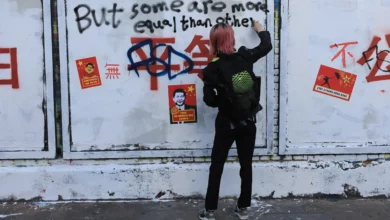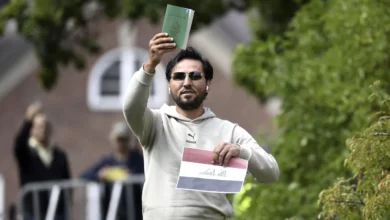This is the second part of an investigative series exploring the question of Islamic radicalism on British campuses. In the previous installment, Al-Masry Al-Youm talked to four City University students about identity and why they chose to adopt a strict Islamic dress.
London–How does a “fundamental Islamist” become “fundamental”? There are common threads to be found in the stories of British Islamic radicals. Many examples can be found of home-grown terrorists who made the conversion to radical Islam during their university years, after being active members of Islamic societies.
One such student was Ahmed Omar Saeed Sheikh, who was convicted for kidnapping Wall Street Journal reporter Daniel Pearl.
In his book Leaderless Jihad, author Marc Sageman traces Sheikh’s journey toward violence. He writes: “Since Omar’s crimes were committed in the name of religion, a key question is, when did he become religious?”
According to Sageman, accounts of Sheikh’s childhood do not suggest that he was “particularly religious” before his university days. However it seems that after he began studies at the London School of Economics (LSE) in 1992 and joined its Islamic society, the downfall that eventually led him to join the ranks of the Pakistani militia Harakutul Mujahedin began. He couldn’t “settle down,” according to the diary he wrote at the time, and “the appeal of Jihad was becoming overwhelming.”
Yassin Nassasri, a Muslim “university drop-out,” in the words of British paper the Daily Telegraph, was in 2007 sentenced to three and a half years in prison for attempting to smuggle into the country blueprints for how to build a missile. Nassasri was the former president of the University of Westminster Islamic Society.
Ed Husain is the author of The Islamist, which tracks his personal journey towards militant Islam. Husain first became active in the Tower Hamlet College’s Islamic Society, where he channeled his commitment and drive to Islamism, then later became a hard-line member of the notorious Hizbut Tahrir (HT) at the LSE Islamic society.
Shiraz Maher has written and spoken about his transition from being a member in an Islamic society (ISOC) on campus to becoming a member of a radical group. At Leeds University Maher became an Islamic activist and then joined the HT. He felt forced to choose between being a Muslim and being British. In his own words, he started by being a committed Muslim, and “then everything changed.”
Neither Maher nor Husain were terrorists, but they adopted the separatist worldview propagated by HT, an organization which doesn’t directly support terrorism, as Maher explained in a BBC Panorama documentary, but “wants a revolution.”
Some Islamic societies washed their hands of ex-members who turned radical. Maher was reportedly thrown out of the Leeds ISOC for confrontational behavior and promoting extreme ideologies.
But arguably the same Islamic societies that expelled these students are the very places in which people like Husain, Maher and Sheikh were introduced to extremist thought, or nurtured an already-budding passion for an extremist strand of Islam.
Events, literature, internet groups, and a network of peers and imams who fueled their zeal, whether intentionally or not, contributed to the development of a mindset that gradually became intolerant of “the West” and ended up refusing non-Muslims all together.
Husain has often tied Islamism and Wahabism to the rise of extremism, and openly labels this a “threat.” Wahabism is a school of thought in Islam based on the teachings of Imam Muhammad Bin Abdul Wahab, a Saudi 18th century Islamic scholar who re-introduced a conservative and literalist form of Islam upon which Saudi Arabia’s religious laws are now based.
With Saudi sponsorship, Wahabi thought managed to infiltrate many schools, mosques and Islamic institutions in both the Middle East and Europe and is generally promoted as the “purest” form of Islam. Outside of Saudi Arabia, the thought is mainly known as Salafism.
While Islamism, simply put, is a form of politicized Islam or identity politics, according to American political analyst and ex-spy Graham Fuller, in its extreme form it can be a “revolution” the goal of which is to establish a global Islamic empire—and violence as a means to this end may be condoned.
Husain warns that Wahabism or Salafism can become a problem if it becomes a launch-pad for Islamism.
“Islamism and Wahabism undermine the very fabric of Islam; combined, these ideologies are a subversive influence on Muslim communities across the globe and a security threat to the West,” writes Husain, who, because of his views, has become a punch-bag for many hardline Islamists and devout Wahabis.
Husain’s views are supported by authors and anti-war activists like Milan Rai, who writes in his book 7/7: The London Bombings, Islam and the Iraq War that Muslims and non-Muslims alike should strive to prevent Salafism and Islamism from joining.
This is not to say that Salafism breeds violence. Salafism as a form of fundamentalism does not equal terrorism or even Islamism. This is confirmed by Hannah Stuart, analyst with the British Centre for Social Cohesion and expert on radicalization.
“You have to be very careful to distinguish between religious conservatism and pseudo-religious political extremism,” she says. “You have to be very careful not to condemn both. It’s not the fault of conservatism that some people take it too far.”
However, conservatism coupled with particular ideas or threats can be dangerous. Rai writes: “What often unites violent and reclusive forms of Islamic fundamentalism is the belief that Islam is under attack”–a belief that is not only common among some students, as we will see later in this series, but is continually strengthened not only by literature, figures and websites popular among university Islamic societies, but also by incidents in which Muslims have been attacked or discriminated against because of their faith.
A British government Foreign and Home Office dossier leaked in 2005 stated that students are especially vulnerable to radicalization. According to the dossier, “extremists are known to target schools and colleges where young people may be very inquisitive but less challenging and more susceptible to extremist reasoning/arguments.”
But is it possible to recognize the signs flagging the path to extremism?
The next part in this series explores radicalization and how it works.




